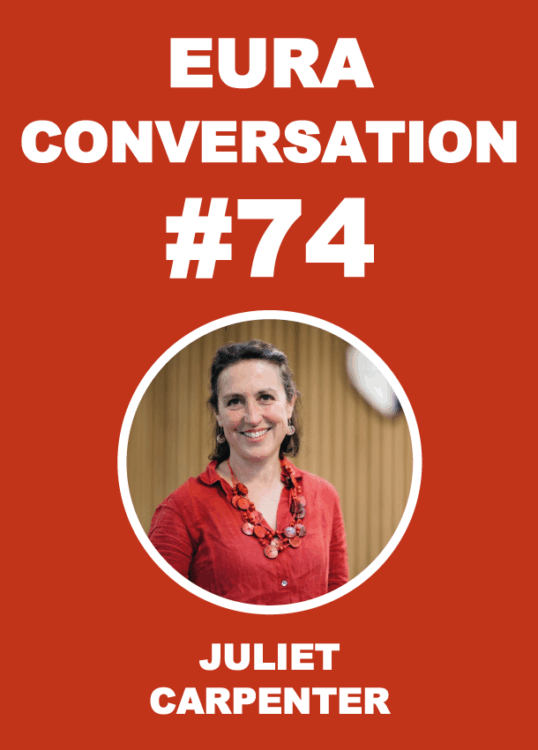
EURA Working Group on Municipal Councillors – News July 2025
15/07/2025
Urban Research & Practice – Volume 18, Issue 3
31/07/2025Conversation #75
Urban mobility as a political conflict
by Mikko Vesterinen
Tampere University, Finland
 Car-free zones have become a new normal in many European cities. Cities like Paris, Milan, London and Oslo have restricted car-driving in the city centres to improve air quality, reduce congestion, and enhance urban amenities. Car-free zones are seen as a key means of reducing emission from transport and to reach climate neutrality by 2050. Today, transport emissions represent around 25 % of the EU’s total greenhouse gas emissions (European Commission 2025). According to the European Commission, achieving climate-neutrality requires ambitious changes in transport in all levels: continentally, nationally and locally.
Car-free zones have become a new normal in many European cities. Cities like Paris, Milan, London and Oslo have restricted car-driving in the city centres to improve air quality, reduce congestion, and enhance urban amenities. Car-free zones are seen as a key means of reducing emission from transport and to reach climate neutrality by 2050. Today, transport emissions represent around 25 % of the EU’s total greenhouse gas emissions (European Commission 2025). According to the European Commission, achieving climate-neutrality requires ambitious changes in transport in all levels: continentally, nationally and locally.
Change never happens without growing pains. Changes in transport systems have triggered a lot of resistance from citizens as cities have taken space for cycling, pedestrians and public transport from car-drivers. In the UK, car-free neighbourhoods have met significant opposition, with protesters claiming that politicians and planners have declared “war on cars” (e.g. Euronews 2023; Williams 2015). In Finland, restrictions on private car-driving have been blamed for the downfall of city centres and harming local businesses. In the spring municipal elections, transport planning was one of the hot topics in many Finnish cities.
Urban transport policy is heating up emotions across Europe: mobility and transportation have become highly politicized and contested issue through struggles over who has the right to the city (e.g. Freudendal-Pedersen and Kesselring 2024; Harvey 2018). At the same time, it has turned transport policy into a culture war in which transport modes have each become associated with a certain lifestyle, creating political divisions between these diverse transport modes, especially between car-drivers and cyclists.
Transport planning has become a part of identity politics
Corey Robin (2017) has argued that conservatism is based on a feeling of loss. In my view, this is very much the case in resisting changes in urban transport systems in which changes in urban space is perceived as a threat to the traditional mobility, based on a private car driving. Finland, like many other Western countries, has a very car-dependent transport system. The ownership of a private car is seen as a necessity and a part of the concept of a good citizen. In addition to this, private car driving has traditionally been associated with prosperity, individual freedom and consumption (e.g. Klein 2024). A private car is still seen promoting individualism, economic growth and employment which is why restricting car-driving is perceived as bad for the economy.
In this confrontation, cycling lines and tram traffic represent “a new urban mobility” which threatens a private car driving and the positive attitudes associated with it. This is particularly evident in the conflict between cycling and motorists as the new cycling lines often mean restriction on car driving.
The conflict has created a new political divide where the dividing line is the attitude towards promotion of the urban mobility mode. This dividing line is not about which mode of urban mobility is the most efficient or environmentally friendly, but transport policy has become extension of identity politics. Eva Heinen (2016) has, for example, noted that car use is often perceived as a status symbol which is why career-oriented individuals are more appealed to car use as career-oriented may be more status-oriented. Similarly, she says that those who identify as countryside or nature lovers may potentially have a higher likelihood of intending to cycle as cycling allows for a greater appreciation of nature compared to most other modes.
In the political debate this is reflected in how political parties represent cycling, pedestrians, public transport and car-driving. In Finland: centre-right parties emphasize motorists and left-green parties would like to promote cyclists and pedestrian friendly urban environment. At the same time, they profile themselves as representing the identities of certain groups of people who use certain modes of transport.
This political divide can be found in other European countries. In Germany, Laura Brune (2024) has noticed that transport policy has changed from an issue-oriented policy to a party-political issue. She finds that centre-right parties emphasize motorists while the Greens speak for cyclists. Examples from Germany and Finland prove that transport policy is indeed political, and it is not isolated from the rest of the political development of society. This is well illustrated by the climate impact of transport where reducing emissions is a key target for achieving international and national carbon neutrality targets.
Cities can be as progressive problem solvers
Reducing emissions is essential for mitigating the effects of climate change and biodiversity loss. As Conversation #69 highlights, cities have a pivotal role in achieving climate targets as nation states have started to shirk their responsibilities in climate actions. At the same time, President Donald Trump has attacked on science, climate actions, his allies and the international order in unprecedented way.
Simon Otjes (2024) has written that municipalities are efficient decision-makers because municipalities focus on very concrete issues which makes their decision-making less ideological and polarised. Cities have the capacity to act as progressive forces and provide solutions to problems even when states cannot. This require that transport policy and other issues of urban planning involve better identity political factors and social meanings of urban space into a planning phase.
In democracies, it is necessary that different possibilities are discussed broadly in public and in political debates. However, if we want to develop environmentally and socially sustainable transport systems in cities, we need to bring people together – not separate them. This will not be possible if transport policy focuses more on identity politics rather than social and environmental issues. Tampere, the third largest city in Finland, is a good example of this as they managed to build and expand a new tramway system in the city region. By focusing on deepening cooperation between municipalities and the wider benefits of different transport solutions, transport systems can be made more sustainable in city regions.
References:
Brune, Laura. 2024. Parteispezifische Differenzen in der Ansprache von Verkehrsteilnehmer*innen: Eine Analyse schriftlicher Anfragen aus deutschen Großstädten. Hannover: DNGPS Working Paper.
Euronews. 2023. ”What are the economic benefits of car-free cities?” Published 21.09.2023.
European Commission. 2025. ”Providing efficient, safe and environmentally friendly transport”.
Freudendal-Pedersen, Malene, and Sven Kesselring. 2024. ”Contested mobilities and the role of conflict in making sustainable cities”. In the book Conflicts in Urban Future-Making. Governance, Institutions, and Transformative Change, Urban Future Making, p. 207–227.
Harvey, David. 2018. ”Contested Cities: Social process and spatial form”. Teoksessa Transforming Cities: Contested Governance and New Spatial Divisions, toim. Nick Jewson ja Susanne Macgregor. Taylor & Francis, p. 19–27.
Heinen, Eva. 2016. ”Identity and travel behaviour: A cross-sectional study on commute mode choice and intention to change”. Transportation Research Part F: Traffic Psychology and Behaviour 43: 238–253.
Klein, Nicholas J. 2024. ”Subsidizing Car Ownership for Low-Income Individuals and Households”. Journal of Planning Education and Research 44(1): 165–177.
Otjes, Simon. 2024. ”Local Political Space. Localism, the Left-Right Dimension and Anti-elitism”. Party Politics 30(4): 662–677.
Robin, Corey. 2017. The Reactionary Mind: Conservatism from Edmund Burke to Donald Trump. New York City: Oxford University Press.
Williams, Zoe. 2015. ”Bikes vs Cars: why it’s war between cyclists and drivers on city streets”. The Guardian. Published 03.05.2025.







Mikko Vesterinen’s blog about urban mobility as a political conflict is a story of ideology, identity, and the challenge of inclusive decision making. It offers a compelling analysis of how urban transport transitions in Europe have become entangled with identity politics, transforming a policy field from a technocratic exercise into a cultural battleground. There are two key tensions at play. Firstly, one that risks deepening urban divisions through politicised narratives, and a second, more hopeful opportunity to reframe transport transitions in ways that build shared identities around sustainability and justice.
The move towards car-free zones and the reallocation of road space have sparked resistance rooted not merely in material inconvenience but in perceived attacks on identity and status. As Vesterinen notes, private car ownership has long been associated with prosperity, autonomy, and modernity in Western societies where car dependence has been structurally embedded for decades (Mattoli et al, 2020; Sheller & Urry, 2000). The framing of policies that limit car use as a “war on cars” speaks to this as an affront on freedom.
The danger, highlighted ted in Vesterinen’s discussion of the case of Finland and Germany, is that transport policy becomes a proxy for broader political and cultural divides, rather than a site of constructive problem-solving. Sustainable mobility like buses, trains and cycling is seen as the preserve of a left-green agenda, while car use is defended as a conservative symbol of tradition and individual economic strength, in many cases. As Freudendal-Pedersen and Kesselring (2024) argue, the task is to design mobility systems that attempt to reflect plural values and experiences, not simply to replace one dominant system (the car) with another (like bicycle or bus routes) in ways that create division.
Vesterinen suggests an important way forward. Cities, by virtue of their proximity to people and their capacity for pragmatic action, can mediate these conflicts through inclusive planning processes. The useful example of Tampere’s tramway expansion shows how cross-municipal cooperation and attention to broad regional benefits can help to defuse community tensions. As Otjes (2024) suggests, municipal politics often allows for more concrete, less ideologically charged decision-making, reducing the likelihood of populist backlash against climate action policies.
Vesterinen asserts that the future of urban transport must be negotiated. The challenge for planners and politicians is to craft narratives and interventions that overcome identity divides and ideologies to create a sense of shared investment in the city. This requires civic political skill and leadership that ambitious for climate action but also generous to the diverse needs, histories, and aspirations of all citizens.
Indeed, mobility policy has become a polarised battlefield in many European cities. In particular car-friendliness became a major issue. We would argue that the expansion of cycling infrastructure as an additional mode of transport for healthy mobility, leisure and tourism is also supported by conservative politicians, at least in Germany. National Cycling strategies are in place in almost all Western European countries as a study of the European Cyclists’ Federation (2022) shows, as well as funding schemes. However, debates become highly controversial and ideological when it comes to push-measures making car use less attractive such as speed limits, reducing capacities for motorised traffic in the road network and – most emotional – availability and pricing of parking space. As Mark Charlton points out, the intensity of the reactions is not merely a result of material inconvenience, but of perceived attacks on identity.
If the aim is to substantially reduce emissions and other negative impacts of motorised transport by reducing car traffic, push-measures are indispensable. In our own work on mobility policies in German cities, we found out that sequencing of push and pull measures as well as the right policy-mix are crucial (which requires strategic thinking). Improving the conditions for the use of public transport, walking and cycling is an important step towards changed mobility behaviour, but will not be enough if it does not go hand in hand with reduced capacities for motorised transport. Car traffic and its impact will not diminish, if it continues to be the most convenient mode of transport.
Generating acceptance for push measures via narratives highlighting tangible benefits tor the quality of life is a core challenge. Some pioneer cities such as those named by Mikko Vesterinen have succeeded to implement far-reaching interventions in their city-centres. These processes did not necessarily come about because the debate was successfully depoliticised, but because mobility policy was placed at the top of the political agenda, as in the case of Paris Mayor Anne Hidalgo. Cities in Germany have lobbied for more decision making power and recent legislative reforms have given local authorities more opportunities to decide e.g. about speed limits and parking fees for resident parking permits. Having these legal possibilities, opens the way for those cities with the necessary resources and political majorities to go beyond experimental model projects and this will lead to more differentiation between cities.
For quickly reducing greenhouse gas emissions, it is crucial what happens in ordinary cities all over Europe. The hope is that the experiences of pioneer cities will help to generate evidence, narratives and visions and gradually change the mainstream to become “a new normal”. If this spreading will happen and how long it will take is open for debate. It is, however, risky to leave the management of this transformation to the cities. The other levels of the multi-level governance system from EU to national and regional also have a responsibility to use their steering mechanisms to enable a transformation going beyond the valuable and inspiring examples of a limited number of pioneering cities and also targeting longer distance trips beyond city borders.